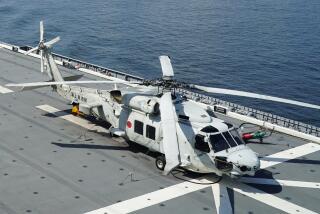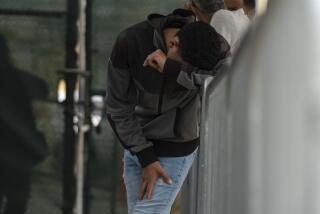Guard Troops, Navy Join Up for War Games
- Share via
ABOARD THE TARAWA, off San Clemente Island — Sailors and soldiers working together. What a concept!
With the eyes of Texas and the White House upon them, infantry troops of the Texas Army National Guard on Thursday lifted off from this massive Navy ship in Army helicopters to mount a mock assault on the military-owned island off the Southern California coast.
The exercise, which began Sunday, is part of an effort by the Bush administration to break down the interservice rivalry and incompatibility that has plagued the U.S. military seemingly since Valley Forge.
Many of the Texans had never been aboard a craft larger than a bass fishing boat.
At a length of 820 feet and displacement of 40,000 tons, the San Diego-based Tarawa took some of them by surprise.
“I kept looking for the Evinrude,” said Sgt. Shane Lindsey.
“I never realized a Navy ship has so many bells and whistles,” said Cpl. Kevin Rodgers.
“I have no idea what they mean except that they’re fixing to say something important.”
For the Navy deckhands, the exercise has meant working with helicopters with un-Navy names--Blackhawk, Chinook and Apache--and different idiosyncrasies than Navy helicopters.
Among other things, the blades on Army helicopters rotate closer to the deck, increasing the need to duck.
“We’ve had a few problems but nothing where we’ve had to close the door and cut the baby in half,” said Navy Capt. Alan Haefner.
That will be welcome news in Washington, where every presidential administration since World War II has promised to force or cajole the military services into what is called “jointness.”
Though there have been notable successes in interservice cooperation--joint training by Marines and the Army’s 82nd Airborne Division, and a command in Florida that combines Navy SEALs, Army Special Forces, and Air Force units--there is a tendency to backslide when the pressure is lifted.
“We’ve been in pursuit of jointness for a very long time,” John E. Peters, military analyst at the Rand Corp. and a retired Army lieutenant colonel, said in a telephone interview. “It takes constant attention and nurturing.”
The idea that the Army and Navy should work in tandem when confronting a common enemy seems obvious, but there are budgetary, tactical, technological and even psychological reasons that make such cooperation hard to achieve.
“Part of the psychological hurdle is that the various services still tend to think in terms of how they can win battles single-handedly, with the other services relegated to support roles,” said John Nelson, a retired Army colonel and former instructor in tactics and operations at the National War College.
Such thinking was blamed for problems during the Persian Gulf War and the invasion of Grenada and contributed to the failure of the Desert One attempt to rescue American hostages in Iran.
Different lingo can be a problem, annoying in peacetime, disastrous during war.
“The Navy speaks a different language,” said Warrant Officer Jack Hyde, one of the Texans aboard the Tarawa.
“Sometimes they don’t speak, they use hand signals, so we’ve spent lots of time in small rooms learning hand signals to figure out what these [Navy] deckhands want us to do.”
The program that brought the Texas Army National Guard to the Tarawa began under the Clinton administration but has gotten a higher profile under President Bush. A study group appointed by Defense Secretary Donald Rumsfeld has called for more joint training.
“We believe that the most transformational concept is to create a truly joint force,” study group Chairman James McCarthy, a retired Air Force general, told a recent Pentagon briefing.
The Texas Army National Guard was chosen for the exercise because it is one of the largest and most highly regarded guard units in the nation. The Tarawa, a helicopter carrier, is designed to deploy with Marines and their aircraft.
Even with a push from the top, the road to jointness will not be smooth.
McCarthy has ruffled the Navy by seeming to doubt the need for a new class of destroyer, the DD-21. And Marine Corps brass have grumbled about Army troops training for amphibious assaults, a Marine specialty.
But on the Tarawa on Thursday, ruffling and grumbling were not options.
There was, however, the ancient problem faced whenever land-based soldiers take to the water: seasickness.
“It’s taken some of our guys a while to get their sea legs,” said Col. James Looney. “I asked one soldier if he had a weak stomach. He said, ‘No sir, I can throw up as far as anybody.’ ”
More to Read
Sign up for Essential California
The most important California stories and recommendations in your inbox every morning.
You may occasionally receive promotional content from the Los Angeles Times.













